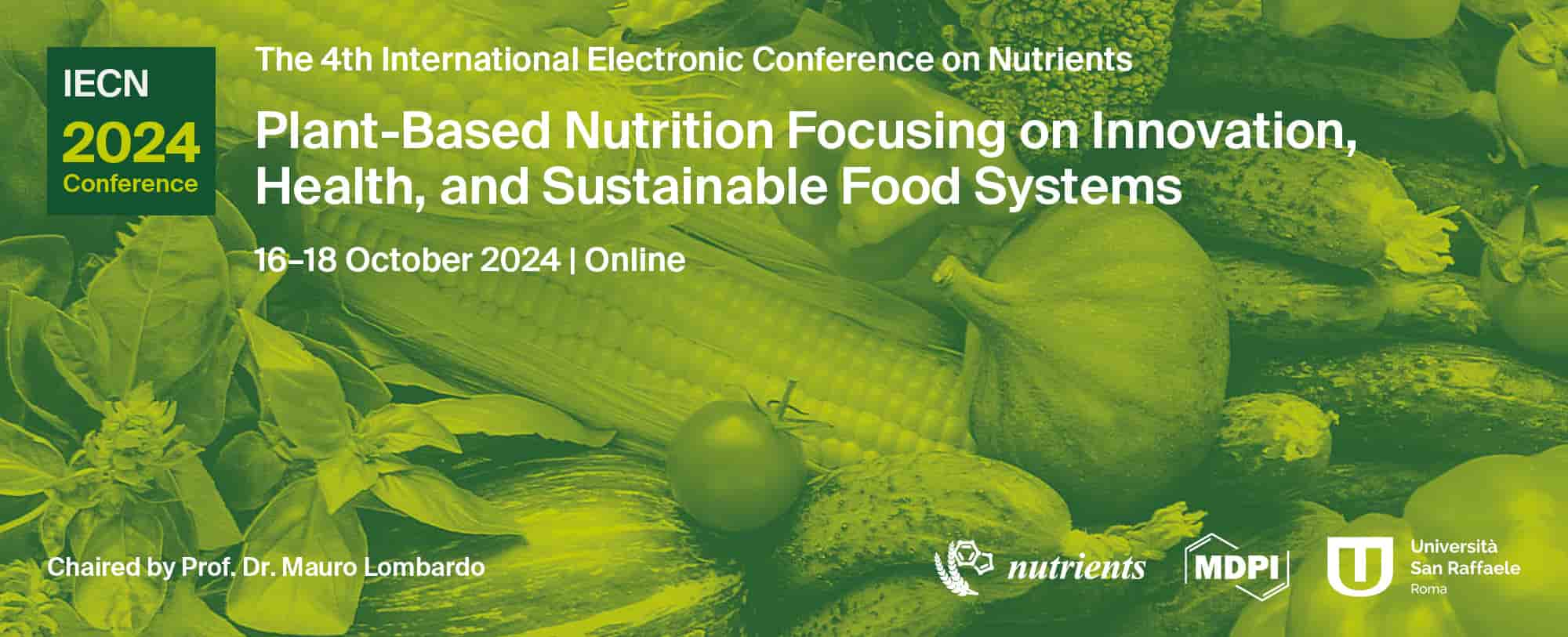Journal Description
Dietetics
Dietetics
is an international, peer-reviewed, open access journal on all aspects of human dietetics published quarterly online by MDPI.
- Open Access— free for readers, with article processing charges (APC) paid by authors or their institutions.
- Rapid Publication: manuscripts are peer-reviewed and a first decision is provided to authors approximately 24.3 days after submission; acceptance to publication is undertaken in 4.9 days (median values for papers published in this journal in the second half of 2023).
- Recognition of Reviewers: APC discount vouchers, optional signed peer review, and reviewer names published annually in the journal.
- Dietetics is a companion journal of Nutrients.
Latest Articles
Common Nutritional Shortcomings in Vegetarians and Vegans
Dietetics 2024, 3(2), 114-128; https://doi.org/10.3390/dietetics3020010 - 06 Apr 2024
Abstract
The popularity of vegetarian and vegan diets is growing due to increased awareness of the environmental and health benefits of such diets. However, despite the consumption of meatless diets being associated with decreased risk of chronic diseases and mortality, followers of these diets
[...] Read more.
The popularity of vegetarian and vegan diets is growing due to increased awareness of the environmental and health benefits of such diets. However, despite the consumption of meatless diets being associated with decreased risk of chronic diseases and mortality, followers of these diets are prone to certain nutritional inadequacies, which could limit health benefits. The main nutrients of concern are vitamin B12, vitamin D, iodine, selenium, calcium, and iron. It is essential for all those following vegetarian and vegan diets to implement vitamin B12 supplementation. To prevent vitamin B12 deficiency, adults should take one oral dose of 50–100 μg cyanocobalamin daily or 2000 μg weekly divided into two oral cyanocobalamin doses. Iodine supplementation is essential for pregnant and breastfeeding women and is recommended for vegetarians and vegans who are unable to access sea vegetables or iodine-fortified foods. The recommended dose of iodine supplement for adults is 150 μg daily. Selenium supplementation should be reserved for individuals with clinical evidence of deficiency due to concerns of adverse effects on lipid profiles and type 2 diabetes risk. It is recommended that vegetarian and vegan adults should supplement 4000 International Units (IU)/d of oral vitamin D to prevent deficiency as sunlight exposure is unreliable due to a range of lifestyle and environmental factors. This recommendation also applies to omnivores. As a precaution, those wishing to transition to a more plant-based diet should consider how they will substitute the nutrition they currently obtain from animal-based foods with plant-based sources or appropriate supplementation.
Full article
Open AccessArticle
One Sheet Does Not Fit All: The Dietetic Treatment Experiences of Individuals with High Eating Disorder Symptomatology Attending a Metabolic and Bariatric Clinic; an Exploratory Mixed-Methods Study
by
Yive Yang, Janet Conti, Milan K. Piya, Caitlin M. McMaster and Phillipa Hay
Dietetics 2024, 3(2), 98-113; https://doi.org/10.3390/dietetics3020009 - 02 Apr 2024
Abstract
►▼
Show Figures
This study aimed to explore the dietetic treatment experiences of individuals with high eating disorder (ED) symptomatology attending a metabolic and bariatric clinic. An exploratory mixed methods cross-sectional study was conducted. Eighteen participants completed the survey, which included an adapted version of the
[...] Read more.
This study aimed to explore the dietetic treatment experiences of individuals with high eating disorder (ED) symptomatology attending a metabolic and bariatric clinic. An exploratory mixed methods cross-sectional study was conducted. Eighteen participants completed the survey, which included an adapted version of the Eating Disorders Treatment Experience Survey (EDTES), the Eating Disorder Examination Questionnaire Short (EDE-QS), and quantitative and qualitative questions relating to the roles and helpfulness of a dietitian in treatment. Data regarding the most and least helpful dietitians were collected. Differences between groups were tested with the Wilcoxon signed ranks test. A reflexive thematic analysis was used to analyse open-ended responses. The mean EDE-QS score reported by participants was 20.9 (SD = 6.0). The dietitians who were perceived as the most helpful were those who took into consideration an individual’s treatment preferences and choices (Z = −1.96, p = 0.05). Three themes were constructed: (1) nutrition knowledge and skills, (2) person-centred care, and (3) roles of the multidisciplinary team. Although further research is required, our findings suggest that the role of a dietitian in this setting may extend beyond weight-loss advice, and with additional training, could include individualised and collaborative supportive care that overlaps with ED treatment.
Full article
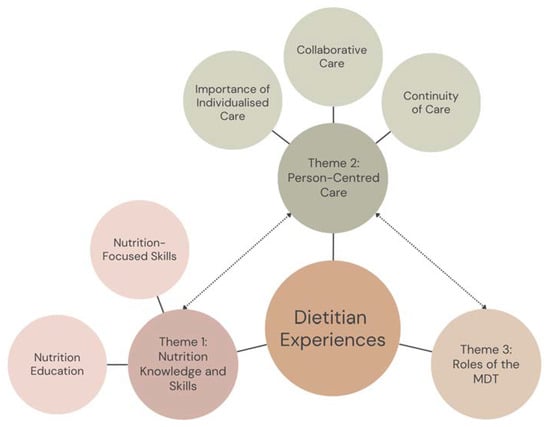
Figure 1
Open AccessArticle
Impact of 5’ Adenosine Monophosphate, Potassium Chloride, and Glycine on the Physicochemical and Sensory Characteristics of Sodium-Reduced Chicken
by
Jhunior Abrahan Marcía Fuentes, Manuel de Jesús Álvarez Gil, Héctor Zumbado Fernández, Ismael Montero-Fernández, Daniel Martín-Vertedor, Ajitesh Yadav and Ricardo S. Aleman
Dietetics 2024, 3(2), 87-97; https://doi.org/10.3390/dietetics3020008 - 22 Mar 2024
Abstract
The demand for low-sodium products is growing worldwide and is compelled by the growing number of related illnesses. However, the quality of these products could be improved, likened to products produced with common salt (NaCL), because the replacement of sodium compromises the flavor
[...] Read more.
The demand for low-sodium products is growing worldwide and is compelled by the growing number of related illnesses. However, the quality of these products could be improved, likened to products produced with common salt (NaCL), because the replacement of sodium compromises the flavor of the product. Reducing sodium salts also poses an essential challenge for the meat industry, since sodium chloride (NaCl) fulfills essential technological functions. High sodium consumption has harmful health implications for cardiovascular and hypertension disorders. As a result, this study aimed to analyze the effect of KCl with Glycine and AMP on the physicochemical and sensory characteristics, purchase intent, and consumer perception of roasted chicken. NaCl/KCl replacement levels (0%, 25%, 50%, 75%, and 100%) were established, and consumer perception, liking, emotions, and purchase intent were evaluated. The different KCl levels, except for firmness, did not impact the physicochemical attributes. Even though higher replacement levels of KCl (75–100%) impacted chicken tenderness, it had no notable impact on panelists’ liking scores and purchase intent. Health claims about the sodium content in roasted chicken have also been shown to significantly increase purchase intent, based on enhancing consumer’s emotional responses. Regarding emotional responses, feelings of being unsafe and worried decreased their scores among the highest KCl replacement levels (75% and 100%). Positive emotional responses (feeling satisfied and pleased) were decisive consumer purchase intent predictors.
Full article
Open AccessArticle
Identification of the Risk Factors Associated with Low Bone Density in Peri- and Early Postmenopausal Women
by
Dave B. Patel, Briana M. Nosal, Manije Darooghegi Mofrad and Ock K. Chun
Dietetics 2024, 3(1), 75-86; https://doi.org/10.3390/dietetics3010007 - 11 Mar 2024
Abstract
►▼
Show Figures
Evidence has shown that one of the most prevalent chronic conditions in postmenopausal women is osteoporosis. Despite the development of some medications, there are still safety and adherence concerns, and, thus, attention has been placed on understanding modifiable risk factors for bone loss.
[...] Read more.
Evidence has shown that one of the most prevalent chronic conditions in postmenopausal women is osteoporosis. Despite the development of some medications, there are still safety and adherence concerns, and, thus, attention has been placed on understanding modifiable risk factors for bone loss. This study aimed to examine the differences in various sociodemographic and body composition factors, physical activity components, and nutrient and food group intake levels among peri- and early postmenopausal women with whole-body bone mineral density (BMD) Z-scores greater than and less than zero. This cross-sectional study utilized baseline data obtained from 45 peri- and early postmenopausal women aged 45–60 years old who participated in a 6-month three-arm, randomized, double-blind, placebo-controlled clinical trial that evaluated the effects of blackcurrant supplementation on bone metabolism. Anthropometric data, BMD values obtained via DXA scans, and self-reported demographic, health, dietary, and physical activity data were collected at baseline. Overall, participants with whole-body BMD Z-scores greater than zero had higher body mass indexes (BMIs), lean mass, fat mass, android fat percentages, ratios of trunk fat mass to limb fat mass, resting metabolic rates, relative skeletal muscle indexes, total and occupational physical activity, alcohol intakes, trans fatty acid intakes, and adequacy of potassium intake, but lower adequacy of vitamin E (p < 0.05). In addition, total calorie intake was positively correlated with added sugar, vitamin E, potassium, alcohol, trans fatty acids, calcium, and vitamin D intakes (p < 0.05); whole-body BMD was positively correlated with added sugars (p < 0.05); vitamin D intake was positively correlated with vitamin E, potassium, trans fatty acid, and calcium intakes (p < 0.05); and calcium intake was positively correlated with added sugar, vitamin E, potassium, and trans fatty acid intakes (p < 0.05). These findings suggest that numerous body composition factors, components of physical activity, and dietary factors are related to bone health in adult women in the menopause transition.
Full article
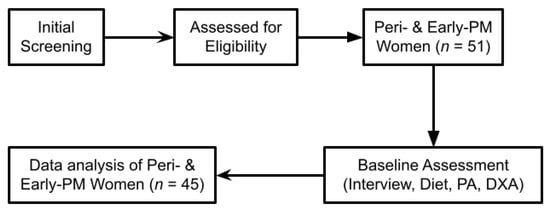
Figure 1
Open AccessArticle
The Physicochemical Characterization, Fatty Acid Profile, and Nutritional Indices of the Greek Traditional Cheese “Tsalafouti”
by
Antonia Samara, Maria Alexandraki, Ermioni Meleti, Athanasios Manouras and Eleni Malissiova
Dietetics 2024, 3(1), 63-74; https://doi.org/10.3390/dietetics3010006 - 06 Mar 2024
Abstract
Tsalafouti cheese, a traditional Greek spreadable cheese, has experienced remarkable popularity over the last decade due to the strong dairy production heritage links that it presents, alongside the special nutritional and sensory attributes that it holds. The aim of this study was to
[...] Read more.
Tsalafouti cheese, a traditional Greek spreadable cheese, has experienced remarkable popularity over the last decade due to the strong dairy production heritage links that it presents, alongside the special nutritional and sensory attributes that it holds. The aim of this study was to chemically characterize the Greek cheese Tsalafouti, with a special focus on its fatty acid profile and the potential nutritional effect it may have. Standard methods were used to assess the physicochemical profile of Tsalafouti cheese, while a fatty acid profile was determined using gas chromatography. The analysis revealed average values, including a pH of 3.94, moisture content of 75.05%, protein content of 8.86%, and fat content of 11.3%. The fatty acid profile highlighted the predominance of health-important fatty acids, such as oleic acid, known for its well-established health benefits. Additionally, the health lipid indices of Tsalafouti were assessed by calculating the atherogenicity index (IA), the thrombogenicity index (IT), the ratio of hypocholesterolemic to hypercholesterolemic fatty acids (HH), the health-promoting index (HPI), and the PUFA-n-6/PUFA-n-3 ratio. The values of these indices indicate the quality concerning proatherogenicity, prothrombogenicity, and the risk of cardiovascular issues. Notably, all the above health indicators are consistent with known health effects. Importantly, the ratio of ω6/ω3 fatty acids aligns with the nutritional recommendations of the World Health Organization. Based on these results, Tsalafouti cheese emerges as a low-fat product and source of protein with potential functional properties, distinguishing itself from other cheeses in the market.
Full article
Open AccessArticle
Relation between Adaptive Eating and Energy Intake Coping Strategies in a Refeed Model for Bodybuilders
by
Wilson Max Almeida Monteiro de Moraes, Ronaldo Ferreira Moura, Ragami Alves, José de Oliveira Vilar Neto, Bruno Magalhães de Castro, Douglas Leão and Jonato Prestes
Dietetics 2024, 3(1), 52-62; https://doi.org/10.3390/dietetics3010005 - 04 Feb 2024
Abstract
►▼
Show Figures
Lean bodybuilder athletes may encounter challenges in adapting their eating habits during ad libitum refeed, either intuitively or consciously. Aims: This paper investigates whether there is a relationship between adaptive eating and energy intake coping strategies in a refeed model for bodybuilders. Methods:
[...] Read more.
Lean bodybuilder athletes may encounter challenges in adapting their eating habits during ad libitum refeed, either intuitively or consciously. Aims: This paper investigates whether there is a relationship between adaptive eating and energy intake coping strategies in a refeed model for bodybuilders. Methods: Fourteen male bodybuilders (29.6 ± 3.1 years; 85.6 ± 6.8 kg, ≥6 competitions) completed a 4-week regimen consisting of 5 days of energy restriction followed by 2 days of refeed. Dietary assessment, body composition (ultrasound), recovery stress questionnaire (REST-Q) and Brunel mood scale (BRUMS) were utilized pre- and post-regimen. Coping function questionnaire (CFQ), mindful eating scale version 2 (MES 2) and the intuitive eating scale-2 (IES-2) were evaluated at the 4th week. Results: Compared to the initial values, the refeed day resulted in a daily caloric increase of 44% compared to the average energy intake on the energy restriction days, culminating in a weekly calorie deficit of 27% and a drop in body mass of 3.1 ± 1.4%. Most participants showed reduced body fat and preserved or gained lean mass. The energy consumption during the refeed maintained an inverse relationship with the perception of satiety (r = −0.9; p < 0.01), the IES 2 total scores (r = −0.82; p < 0.01), as well as the confidence in hunger and satiety cues (r = −0.62; p = 0.02) and congruence in food–body choice dimensions (r = −0.56; p = 0.04). Emotional coping maintained an inverse relationship with the IES 2 total scores (r = 0.54; p < 0.05) and an inverse relationship with energy intake during refeed (r = −0.42; p < 0.05). Conclusion: The results suggest that a heightened perception of internal hunger and satiety signals and higher scores in intuitive eating may contribute to adequate energy intake, even when high scores of emotional coping are present.
Full article

Figure 1
Open AccessArticle
Children Whose Parents Spend More Time Preparing Dinner Eat More Made-from-Scratch Meals
by
Carla Adriano Martins, Luara dos Santos, Mariana Fernandes Brito de Oliveira and Larissa Galastri Baraldi
Dietetics 2024, 3(1), 42-51; https://doi.org/10.3390/dietetics3010004 - 02 Feb 2024
Abstract
The aim of this paper is to investigate associations between the time spent by parents preparing dinner and children’s consumption of made-from-scratch meals. We developed a cross-sectional study with 595 parent–child dyads from São Paulo, Brazil. Data were collected via telephone interviews: time
[...] Read more.
The aim of this paper is to investigate associations between the time spent by parents preparing dinner and children’s consumption of made-from-scratch meals. We developed a cross-sectional study with 595 parent–child dyads from São Paulo, Brazil. Data were collected via telephone interviews: time spent preparing dinner and socio-demographic characteristics were obtained using a questionnaire, while food consumption was recorded via dietary recall. Crude and adjusted regression analyses were used to test associations between time spent preparing dinner and the contribution of made-from-scratch meals to children’s dinner energy intake. Parents (93.1% woman, 60.5% aged 31–41, 62.2% white, 88.4% married, 71.2% employed, 50.0% ≥ 12 years of education) spent an average of 108- and 112-min preparing dinner on weekdays and weekends, respectively. Spending more than two hours/day was positively associated with the consumption of made-from-scratch meals (β = 4.4; p = 0.035). When parents spend more time preparing dinner, their children consume more made-from-scratch meals. Given that cooking from scratch is considered healthier but takes more time, it is important that policies and interventions aimed at promoting healthier meals among children/families and avoiding overburdening women with domestic tasks are accompanied by recommendations that focus on promoting an equitable division of food work among families.
Full article
(This article belongs to the Topic Nutrition Education, Food Literacy and Healthy Diets in Childhood and Adolescence)
Open AccessArticle
Association between Hospital Prescribed Diets and Length of Stay, Re-Presentation, and Gastrointestinal Symptoms among Acute Uncomplicated Diverticulitis Patients: A Prospective Cohort Study
by
Romina Nucera, Julie Jenkins, Megan Crichton, Shelley Roberts, Phoebe Dalwood, Fiona Eberhardt, Sophie Mahoney and Skye Marshall
Dietetics 2024, 3(1), 30-41; https://doi.org/10.3390/dietetics3010003 - 01 Feb 2024
Abstract
Background and aim: Variation in practice has been observed among the prescribed diets for inpatients with acute, uncomplicated diverticulitis. This study aimed to observe outcomes (length of stay (LOS), re-presentations, and gastrointestinal symptoms) for acute, uncomplicated diverticulitis inpatients prescribed restricted or liberalised diets
[...] Read more.
Background and aim: Variation in practice has been observed among the prescribed diets for inpatients with acute, uncomplicated diverticulitis. This study aimed to observe outcomes (length of stay (LOS), re-presentations, and gastrointestinal symptoms) for acute, uncomplicated diverticulitis inpatients prescribed restricted or liberalised diets during usual care. Methods: Adult inpatients with acute, uncomplicated diverticulitis were prospectively enrolled from 2017 to 2019. Demographics, clinical data, and prescribed diets were collected from medical records. Patients were categorised as having restricted or liberalised diets. Primary outcomes were LOS, re-presentations related to diverticulitis, and gastrointestinal symptoms, collected from medical records and patient surveys. Descriptive statistics were used to characterise all variables. Adjusted regression analysis was used to determine the effect of diet prescription on primary outcomes. Results: Of the 81 included patients, 47% were prescribed restricted diets, and 53% were prescribed liberalised diets. Patients prescribed restricted diets had greater LOS (median 4.0 (IQR: 3.5–5.1) vs. 2.8 (IQR: 2.2–3.8) days, p < 0.001) and were more likely to re-present due to diverticulitis at six months (OR 8.1, 95% CI 1.3–51.0, p = 0.025) in adjusted models. No difference in gastrointestinal symptoms was observed 30-days post-admission. Conclusion: In patients hospitalised with uncomplicated diverticulitis, restricted diets may be associated with longer LOS and increased odds of re-presentation at 6 months compared to liberalised diets. No differences in post-discharge gastrointestinal symptoms were observed between restricted versus liberalised diets. Randomised controlled trials are needed to confirm the causal role of inpatient diet prescription on clinical outcomes, healthcare utilisation, and patient experience. Registration: prospectively registered; ANZCTR Number: ACTRN12616001378415.
Full article
Open AccessArticle
Profile Assessment of Bioactive Peptides in the Greek Traditional Cheese “Tsalafouti”
by
Ermioni Meleti, Maria Alexandraki, Antonia Samara, Cecilia Loffi, Tullia Tedeshi, Gianni Galaverna, Athanasios Manouras, Michalis Koureas and Eleni Malissiova
Dietetics 2024, 3(1), 16-29; https://doi.org/10.3390/dietetics3010002 - 16 Jan 2024
Abstract
►▼
Show Figures
In the Greek regions of Agrafa and Tzoumerka, Tsalafouti, a traditional spreadable cheese made from goat’s and sheep’s milk is produced. This product has emerged in recent years as a result of the campaign to acquire Geographical Indication. This study aimed to assess
[...] Read more.
In the Greek regions of Agrafa and Tzoumerka, Tsalafouti, a traditional spreadable cheese made from goat’s and sheep’s milk is produced. This product has emerged in recent years as a result of the campaign to acquire Geographical Indication. This study aimed to assess the biopeptide profile of Tsalafouti cheese in order to highlight its nutritional value. Using HPLC-MS, bioactive peptides in Tsalafouti cheese samples were identified and classified according to their bioactivity. The biopeptides detected are known to present antibacterial, anti-diabetic, anti-hypertensive, anti-thrombotic, antioxidant, and immunomodulatory activities, while ACE enzyme and dipeptidyl-4 (DPP-IV) inhibitors were also identified. Based on these results, Tsalafouti cheese presents an interesting bioactive peptides profile that may act as special motivation for consumers to choose this specific cheese.
Full article
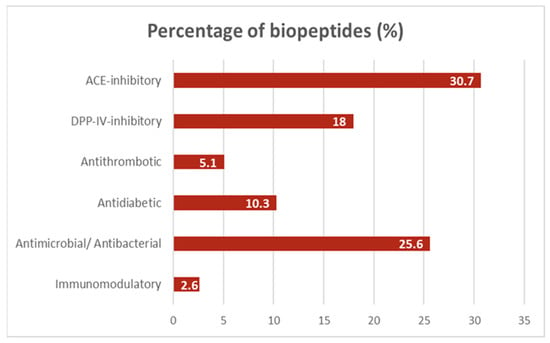
Figure 1
Open AccessArticle
Improving Health through Sustainable and Healthy Urban Food System Policy in Nigeria
by
Onyedika Gabriel Ani and Isaac Duah Boateng
Dietetics 2024, 3(1), 1-15; https://doi.org/10.3390/dietetics3010001 - 11 Jan 2024
Abstract
►▼
Show Figures
Diet-related diseases and mortalities are assuming epidemic proportions globally. It is more worrisome in the Global South, especially in Africa, where the healthcare system is not resilient to the public health burden. There is a growing effort around the world to foster urban
[...] Read more.
Diet-related diseases and mortalities are assuming epidemic proportions globally. It is more worrisome in the Global South, especially in Africa, where the healthcare system is not resilient to the public health burden. There is a growing effort around the world to foster urban food system policies that would checkmate the failing health of the public and ensure improved quality of life. However, these efforts seem non-existent in many African regions. Therefore, there is a need for heightened efforts in these areas to address the food system and ensure a global healthy society. This study identified Nnewi, Nigeria, in sub-Saharan Africa, a typical urban area in Nigeria, and analyzed the public health challenges attributed to the non-existent food system policy and poor nutritional practices. The Milan Urban Food Policy Pact model, which has been successfully implemented in many cities, was adopted to propose a sustainable food system policy for Nnewi. Key policies proposed include autonomous local government power, government-assisted programs, clean and sustainable amenities, agricultural reforms, nutrition education, and reductions in food wastage to achieve a circular economy. An evaluation tool for implementing the food system policy was also developed. Overall, implementing the food system policies proposed herein would improve the quality of life of Nnewi residents. Other urban areas could also adopt similar food system policies to achieve the Sustainable Development Goals of a healthy and resilient global society.
Full article
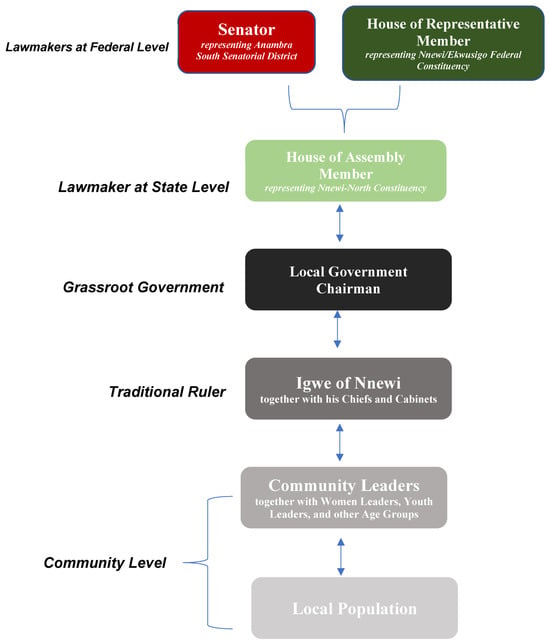
Figure 1
Open AccessArticle
Gestational Age Is Positively Associated with Retinol and α-Tocopherol in Preterm Infants: The Mediating Role of Birth Weight
by
Panos Papandreou, Paraskevi Detopoulou and Maria Skouroliakou
Dietetics 2023, 2(4), 366-376; https://doi.org/10.3390/dietetics2040027 - 18 Dec 2023
Abstract
►▼
Show Figures
Oxidative stress is thought to be one of the common mechanisms for several neonatal diseases in premature infants. Moreover, fat-soluble antioxidant vitamins, i.e., retinol and α-tocopherol, have been found to be low in preterm neonates; however, data are limited. The aim of this
[...] Read more.
Oxidative stress is thought to be one of the common mechanisms for several neonatal diseases in premature infants. Moreover, fat-soluble antioxidant vitamins, i.e., retinol and α-tocopherol, have been found to be low in preterm neonates; however, data are limited. The aim of this was to assess the circulating α-tocopherol and retinol concentrations in preterm infants at birth and investigate if they are related to gestational age. Retinol and α-tocopherol were measured on the first day after birth in 30 preterm neonates with HPLC. Means ± SD of serum retinol and α-tocopherol were 392.0 ± 162.9 μg/L and 6.83 ± 3.02 mg/L, respectively. In total, 73% of infants had a very low birth weight (<1500 g) and 23.3% were small for gestational age (SGA). Moreover, 10% of neonates had a retinol deficiency and 20% had an α-tocopherol deficiency. The retinol concentration was lower in SGA infants compared to appropriate for gestational age ones (340.85 ± 75.89 vs. 407.60 ± 179.83 μg/L, correspondingly p = 0.030). Retinol was linearly related to gestational age (Pearson’s rho = 0.84, p < 0.001) but the association did not remain significant after an adjustment for birth weight (partial rho = 0.193, p = 0.316). α-tocopherol was nonlinearly associated with gestational age (Spearman’s rho = 0.470, p = 0.044). The assessment of the vitamin status and potential deficiency in neonates is crucial in order to appropriately support the nutritional needs of newborns.
Full article
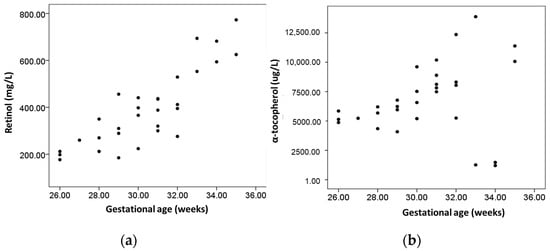
Figure 1
Open AccessArticle
Impact of Corn Fiber on the Physicochemical/Technological Properties, Emotions, Purchase Intent and Sensory Characteristics of Gluten Free Bread with Novel Flours
by
Ricardo S. Aleman, Jhunior Abrahan Marcia Fuentes, Ajitesh Yadav, Shirin Kazemzadeh, Franklin Delcarca, Mallerly Sarmientos, Mehrdad Hasani-Azhdari and Ismael Montero-Fernández
Dietetics 2023, 2(4), 356-365; https://doi.org/10.3390/dietetics2040026 - 12 Dec 2023
Cited by 1
Abstract
►▼
Show Figures
Gluten-free products present huge advantages for individuals with gluten intolerance or celiac disease. The most influential strategy to develop a product comparable to wheat-containing gluten products is to promote its nutritional and sensorial attributes. Recently, rice flour and teosinte flour were used to
[...] Read more.
Gluten-free products present huge advantages for individuals with gluten intolerance or celiac disease. The most influential strategy to develop a product comparable to wheat-containing gluten products is to promote its nutritional and sensorial attributes. Recently, rice flour and teosinte flour were used to develop gluten-free bread. As a result, this work aimed to compare the physical/technological attributes of bread made with rice flour and teosinte flour with corn fiber fortification and examine consumer acceptance and purchase intent. An extreme vertices mixture design decided that a teosinte flour (43.4%), high protein white rice flour (55%), and high protein brown rice flour (1.6%) ratio of gluten-free flour mixture for bread was best based on the sensory attributes utilized for the desirability function methodology. After optimizing the gluten-free flour mixture, the bread was fortified with corn fiber under 1.7 g and 3.8 g per serving, and it was evaluated to examine its physical/technological attributes, consumer perception, liking, emotions, and purchase intent. Incorporating fiber into gluten-free bread impacted the color and texture, giving lighter and yellower colors with a firmer texture. Likewise, concerning health benefit claims, gluten-free bread with fiber claims only improves the purchase intent and overall liking of bread containing 1.7 g per serving of fiber. The flavor attribute was the main driver for consumers’ purchase decisions. This product could be beneficial for consumers who are seeking fiber in their diet.
Full article
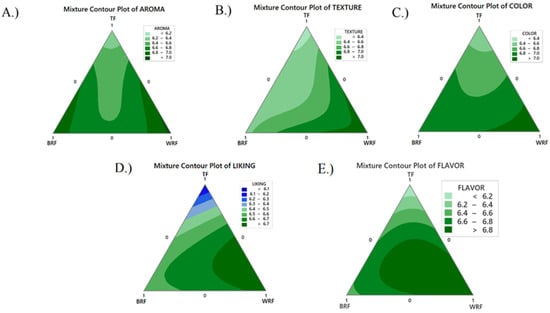
Figure 1
Open AccessArticle
Nutrition Knowledge and Diet in Female College Students in Turkey: Youth Education in Nutrition Initiative/Nutrition Education Works (YENI/NEW)—A Cross-Sectional Pilot Study
by
Esra Dandin, Pelin Karaboga, Arzu Uzun, Kennidy P. Taylor and Aleksandra S. Kristo
Dietetics 2023, 2(4), 344-355; https://doi.org/10.3390/dietetics2040025 - 07 Dec 2023
Cited by 1
Abstract
Healthy dietary patterns can play a major role in preventing chronic diseases. Improving nutrition-related knowledge in young individuals is considered a promising approach to adopting healthy dietary behaviors, thus improving outcomes later in life. However, healthy eating habits in college students may prove
[...] Read more.
Healthy dietary patterns can play a major role in preventing chronic diseases. Improving nutrition-related knowledge in young individuals is considered a promising approach to adopting healthy dietary behaviors, thus improving outcomes later in life. However, healthy eating habits in college students may prove challenging to acquire and maintain. This cross-sectional pilot study aimed to investigate the relationship between nutrition knowledge and its effect on dietary factors, body weight, and body composition in female college students in Turkey. Second- and third-year female college nutrition students (NS), (n = 85) and corresponding non-nutrition/non-health sciences students (NNS) (n = 80), aged 20–22 years old, were evaluated using a validated nutrition knowledge questionnaire, 24 h recalls, anthropometry, and body composition analysis using bioelectrical impedance during the 2015–2016 academic year. The findings revealed that nutrition knowledge was positively associated with increased intake of water, fruits and vegetables, grains, and fiber, whereas total carbohydrate intake exhibited an inverse relationship with nutrition knowledge. Moreover, protein and lipid intake, while not significant, appeared to show higher and lower values, respectively, for the NS participants compared to NNS, revealing a healthier trend for more nutrition-knowledgeable students, which was similar to the finding of a marginally better body composition profile in nutrition-knowledgeable students. As young adulthood is critical for the development of dietary habits, demonstrating the effectiveness of nutrition education is important as a potential tool for public health in terms of improving the risk of chronic diseases.
Full article
Open AccessArticle
Comparing Self-Reported Dietary Intake to Provided Diet during a Randomized Controlled Feeding Intervention: A Pilot Study
by
James L. Casey, Jennifer L. Meijer, Heidi B. IglayReger, Sarah C. Ball, Theresa L. Han-Markey, Thomas M. Braun, Charles F. Burant and Karen E. Peterson
Dietetics 2023, 2(4), 334-343; https://doi.org/10.3390/dietetics2040024 - 17 Nov 2023
Cited by 1
Abstract
►▼
Show Figures
Systematic and random errors based on self-reported diet may bias estimates of dietary intake. The objective of this pilot study was to describe errors in self-reported dietary intake by comparing 24 h dietary recalls to provided menu items in a controlled feeding study.
[...] Read more.
Systematic and random errors based on self-reported diet may bias estimates of dietary intake. The objective of this pilot study was to describe errors in self-reported dietary intake by comparing 24 h dietary recalls to provided menu items in a controlled feeding study. This feeding study was a parallel randomized block design consisting of a standard diet (STD; 15% protein, 50% carbohydrate, 35% fat) followed by either a high-fat (HF; 15% protein, 25% carbohydrate, 60% fat) or a high-carbohydrate (HC; 15% protein, 75% carbohydrate, 10% fat) diet. During the intervention, participants reported dietary intake in 24 h recalls. Participants included 12 males (seven HC, five HF) and 12 females (six HC, six HF). The Nutrition Data System for Research was utilized to quantify energy, macronutrients, and serving size of food groups. Statistical analyses assessed differences in 24 h dietary recalls vs. provided menu items, considering intervention type (STD vs. HF vs. HC) (Student’s t-test). Caloric intake was consistent between self-reported intake and provided meals. Participants in the HF diet underreported energy-adjusted dietary fat and participants in the HC diet underreported energy-adjusted dietary carbohydrates. Energy-adjusted protein intake was overreported in each dietary intervention, specifically overreporting beef and poultry. Classifying misreported dietary components can lead to strategies to mitigate self-report errors for accurate dietary assessment.
Full article
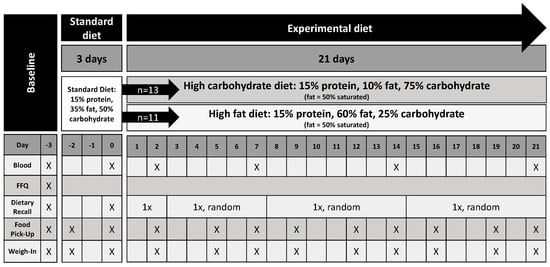
Figure 1
Open AccessReview
Historical Perspective and Current State Review: Advancing Lifelong Learning and Continuing Professional Education in Nutrition and Dietetics to Expand Opportunities, Equity, Access, and Future Transformations
by
Andie Lee Gonzalez, Patricia A. Lynch, Becky Dorner and Mary Beth Arensberg
Dietetics 2023, 2(4), 321-333; https://doi.org/10.3390/dietetics2040023 - 08 Nov 2023
Abstract
►▼
Show Figures
Lifelong learning has been integral to advancement of the nutrition and dietetics profession and its practitioners. Both the United States (US) Commission on Dietetic Registration (CDR) and the Academy of Nutrition and Dietetics (Academy) advocate for continuous skill development and professional growth. Responding
[...] Read more.
Lifelong learning has been integral to advancement of the nutrition and dietetics profession and its practitioners. Both the United States (US) Commission on Dietetic Registration (CDR) and the Academy of Nutrition and Dietetics (Academy) advocate for continuous skill development and professional growth. Responding to evolving environmental trends and diverse practice perspectives, the CDR joined the Joint Accreditation for Interprofessional Continuing Education organization in 2020, and the CDR is transforming its own continuing professional education (CPE) requirements and prior-approval program. This paper presents a historical perspective and a current state narrative review, chronicling past and recent developments in nutrition and dietetics CPE in the US, including opportunities for reflective learning and interprofessional continuing education (IPCE). Also explored are the establishment and expansion of the Joint Accreditation organization and its standards, as well as applicable case examples. Additionally, this paper outlines the CDR and the Academy’s strategies for advancing inclusion, diversity, equity, and access (IDEA) within the profession and identifies how CPE advancements may facilitate accessible and equitable CPE for an increasingly diverse membership of practitioners. Nutrition and dietetics professionals stand to benefit from a more comprehensive understanding of changes in CPE and the opportunities they may bring to the future of the profession.
Full article

Figure 1
Open AccessReview
A Narrative Review of the Tale of the Dysbiotic Microbiome in the Preterm Neonate
by
Marwyn Sowden, Evette van Niekerk, Andre Nyandwe Hamama Bulabula and Mirjam Maria van Weissenbruch
Dietetics 2023, 2(4), 308-320; https://doi.org/10.3390/dietetics2040022 - 24 Oct 2023
Abstract
►▼
Show Figures
Background: Researchers have established that the preterm neonate is born with an immature gastrointestinal tract. The preterm neonate is thus susceptible to various complications often seen in the neonatal intensive care unit, e.g., feeding intolerances, necrotizing enterocolitis, and hospital-acquired bloodstream infections. These complications
[...] Read more.
Background: Researchers have established that the preterm neonate is born with an immature gastrointestinal tract. The preterm neonate is thus susceptible to various complications often seen in the neonatal intensive care unit, e.g., feeding intolerances, necrotizing enterocolitis, and hospital-acquired bloodstream infections. These complications can be life-threatening, and if survived, can have an unfavorable effect on the neonate’s growth and development. Aim: The aims of this narrative review article were to provide an in-depth understanding of the various factors contributing to the development of the preterm neonatal microbiome. Further, we reviewed gastrointestinal microbiome dysbiosis and its potential role in the development of feeding intolerances, necrotizing enterocolitis, and hospital-acquired bloodstream infections. Lastly, we described the potential role of probiotics in this vulnerable population. Methods: A PubMed database search was conducted identifying articles that describe the development and function of the neonatal microbiome, the role of gastrointestinal dysbiosis, and the development of neonatal complications as well as the role of probiotics in gastrointestinal dysbiosis. Results: Various maternal, neonatal, and environmental factors play a role in the development of gastrointestinal dysbiosis in the preterm neonate. This can lead to feeding intolerances, necrotizing enterocolitis, and hospital-acquired bloodstream infections. Discussion: The pathogenesis of the development of short-term complications in the preterm neonate can be linked to the immaturity of the host immune system as well as alterations seen in the intestinal microbiome. There is a growing body of evidence that probiotics can play a role in preventing dysbiosis and thus complications observed in the preterm neonate. However, the optimal combination of probiotic strains and dosage still needs to be identified.
Full article

Figure 1
Open AccessReview
Exercise-Induced Gastrointestinal Symptoms in Endurance Sports: A Review of Pathophysiology, Symptoms, and Nutritional Management
by
Emanuela Ribichini, Giulia Scalese, Alessandra Cesarini, Chiara Mocci, Nadia Pallotta, Carola Severi and Enrico Stefano Corazziari
Dietetics 2023, 2(3), 289-307; https://doi.org/10.3390/dietetics2030021 - 19 Sep 2023
Abstract
►▼
Show Figures
Strenuous exercise can be associated with “Exercise Induced Gastrointestinal Syndrome” (Ex-GIS), a clinical condition characterized by a series of gastrointestinal (GI) disturbances that may impact the physical and psychological performance of athletes. The pathophysiology comprises multi-factorial interactions between the GI tract and the
[...] Read more.
Strenuous exercise can be associated with “Exercise Induced Gastrointestinal Syndrome” (Ex-GIS), a clinical condition characterized by a series of gastrointestinal (GI) disturbances that may impact the physical and psychological performance of athletes. The pathophysiology comprises multi-factorial interactions between the GI tract and the circulatory, immune, enteric, and central nervous systems. There is considerable evidence for increases in the indices of intestinal damage, permeability, and endotoxemia associated with impaired gastric emptying, slowing of small intestinal transit, and malabsorption of nutrients. Heat stress and racing mode seem to exacerbate these GI disturbances. GI symptomatology that derives from strenuous exercise is similar to that of IBS and other GI functional disorders defined in the Rome IV Criteria. To manage Ex-GIS, the exercise modality, state of dehydration, environmental temperature, concomitant therapies, and self-managed diet should be evaluated, and if risk elements are present, an attempt should be made to modify them. Multiple strategies can be successively adopted to manage Ex-GIS. Nutritional and behavioral interventions appear to be the principal ones to avoid symptoms during the exercise. The aim of this review will be to explore the pathophysiology, clinical aspect, and current literature on behavioral and nutritional strategies to manage Ex-GIS, regarding a gluten-free diet and low-fermentable oligo-, di-, and mono-saccharides and polyols (FODMAP) diet.
Full article
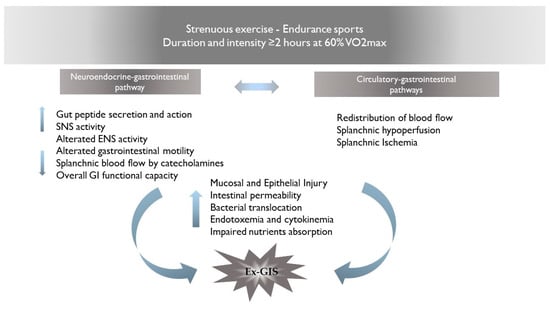
Figure 1
Open AccessReview
The Lower the Better? Discussion on Non-Alcoholic Wine and Its Marketing
by
Frederik Nikolai Schulz, Hadi Farid and Jon H. Hanf
Dietetics 2023, 2(3), 278-288; https://doi.org/10.3390/dietetics2030020 - 30 Aug 2023
Cited by 1
Abstract
In the German beverage market, a shift in consumption has become apparent in recent decades: away from alcoholic beverages and towards non-alcoholic alternatives. This indicates a tradeoff between two important and nutritionally relevant substances: alcohol and sugar. This review, therefore, addresses the question
[...] Read more.
In the German beverage market, a shift in consumption has become apparent in recent decades: away from alcoholic beverages and towards non-alcoholic alternatives. This indicates a tradeoff between two important and nutritionally relevant substances: alcohol and sugar. This review, therefore, addresses the question of the significance of these developments to the German wine industry, where non-alcoholic wines and sparkling wines are becoming increasingly important. The production of these products is accompanied by a reduction in alcohol content with a simultaneous increase in sugar. Furthermore, these products could also become the focus of health policy efforts when it comes to accusations of possible “alibi marketing”. Here, parallels with the handling of tobacco products become clear, while the tradeoff between alcohol and sugar recedes into the background.
Full article
Open AccessArticle
Lessons Learnt from Rapid Implementation of Telehealth in a Paediatric Dietetics’ Outpatient Service: Is There a Silver Lining beyond the Coronavirus Pandemic to Support Patient-Centred Care?
by
Araceli Llanos Jeri, Kelly Lambert, May Mak and Marika Diamantes
Dietetics 2023, 2(3), 267-277; https://doi.org/10.3390/dietetics2030019 - 04 Aug 2023
Abstract
The aim of this paper is to report on the differences in clinical and service engagement outcomes of patients attending the paediatric dietetic outpatient service at a major metropolitan hospital before the outbreak of the coronavirus (using face-to-face care) and during the pandemic
[...] Read more.
The aim of this paper is to report on the differences in clinical and service engagement outcomes of patients attending the paediatric dietetic outpatient service at a major metropolitan hospital before the outbreak of the coronavirus (using face-to-face care) and during the pandemic (using telehealth). This paper also reports on learning lessons from the rapid implementation of telehealth in this service. This study collected pre- and post-coronavirus pandemic data from 44 paediatric patients. Data on outcomes pre- and post-implementation were analysed. There were no statistically significant differences between pre- and post-coronavirus data for growth (p = 0.92), adherence to dietetic recommendations (p = 0.08) or attendance rate (p = 1.00). This study also found a low uptake of virtual telehealth, technical issues and suboptimal anthropometric data collection associated with this modality of care. Telehealth was not associated with a change in clinical and service engagement outcomes. Thus, telehealth service delivery is not inferior to usual face–face dietetic care and has the potential to be a useful adjunct to usual nutrition care for paediatric health service users after the coronavirus pandemic.
Full article
Open AccessReview
The Relationship of Fruits and Fruit-Products Consumption with Glucose Homeostasis and Diabetes: A Comprehensive Update on the Current Clinical Literature
by
Ines Ellouze, Neda Akhavan, Saiful Singar, Kallie Dawkins, Ravinder Nagpal and Bahram Arjmandi
Dietetics 2023, 2(3), 237-266; https://doi.org/10.3390/dietetics2030018 - 20 Jul 2023
Abstract
Type 2 diabetes mellitus is a major contributor to morbidity and mortality worldwide. This disease often leads to poor health outcomes, such as neuropathy and diabetic foot ulcers, and increased risk for comorbidities such as cardiovascular complications and renal disease. Lifestyle modifications including
[...] Read more.
Type 2 diabetes mellitus is a major contributor to morbidity and mortality worldwide. This disease often leads to poor health outcomes, such as neuropathy and diabetic foot ulcers, and increased risk for comorbidities such as cardiovascular complications and renal disease. Lifestyle modifications including diet and physical activity interventions are often explored as prevention and management strategies for T2DM. It is well established that fruits are a rich source of fiber and a variety of phytochemicals, vitamins, minerals, and bioactive compounds that can help optimize human health. Unfortunately, many experts associate the consumption of fruit with a moderate to high glycemic index (GI), which leads to a spike in blood glucose and eventually elevated hemoglobin A1c (HbA1c). The purpose of this comprehensive review is to outline the current clinical literature on the relationship between fruit consumption and various indices of glucose metabolism. A variety of fruits have been clinically studied to determine this relationship, namely in the fresh form (e.g., berries, apples, watermelon, cherries, mangoes), dried fruits (raisins and dates), and juices (derived from cranberry, orange, grape, cherry, and pomegranate). Overall, intake of fruits and fruit-derived products is beneficial for healthy subjects and subjects with T2DM regarding their impact on glucose metabolism and other cardiometabolic markers (e.g., inflammatory responses, lipid profiles). Nonetheless, it is more advisable for diabetic patients to consume fresh or dried fruits rather than fruit-derived products. A special consideration needs to be attributed to both the amount of fruit intake with regards to their respective GI and glycemic load (GL), and when these fruits are consumed. Trials with more a comprehensive design and specific outcomes are required to reveal the mechanisms underlying the beneficial effects of fruit consumption on the T2DM population particularly.
Full article
(This article belongs to the Topic Recent Advances in Consumers’ Preferences and Behavior toward Healthy and Functional Foods)
Highly Accessed Articles
Latest Books
E-Mail Alert
News
Topics
Topic in
Agriculture, Animals, Dietetics, Foods, Insects
Edible Insects as Feed and Food: Opportunities and Challenges
Topic Editors: Rifat Ullah Khan, Shabana NazDeadline: 31 July 2024

Conferences
Special Issues
Special Issue in
Dietetics
Vitamin D in the New Decade: Facts, Controversies, and Future Perspectives for Daily Clinical Practice
Guest Editor: Spyridon N. KarrasDeadline: 15 December 2024






